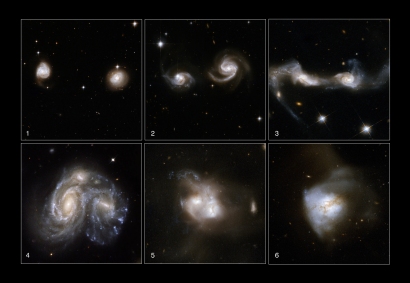Welcome to our first week of articles for the fall 2014 semester! This week's topic is galactic cannibalism, which is, in fact, as cool as it sounds.
You're probably familiar with the concept of a galaxy (a collection of stars, gas, and dark matter that generally swirl around in space). To look at pictures of galaxies and think of their sizes and ages, you might conclude that galaxies are immovable and unchanging constructs. After all, what force in the universe could be strong enough to move or mangle a galaxy?
You're probably familiar with the concept of a galaxy (a collection of stars, gas, and dark matter that generally swirl around in space). To look at pictures of galaxies and think of their sizes and ages, you might conclude that galaxies are immovable and unchanging constructs. After all, what force in the universe could be strong enough to move or mangle a galaxy?
The answer, it turns out, is other galaxies.
Because galaxies are so massive, the gravitational forces between them are strong enough to overcome the vast distance between them and create a notable acceleration. So, galaxies often hurl toward each other on a collision course. Even our own Milky Way Galaxy will collide with the Andromeda Galaxy in about 4.5 billion years. (We'll read more about our impending doom later!)
But that's not all: Because galaxies aren't rigid objects, but a collection of individual stars and gas clouds, galaxies on a collision course also distort each other.
Here's how it works: Suppose you're on earth as the Andromeda Galaxy approaches the Milky Way, and let's suppose the Milky Way is oriented such that Andromeda is approaching toward the Alpha Quadrant as depicted in
 |
| Image credit: http://www.freewebs.com/captaingestl/milkyway.gif |
Now, let's suppose you have a Borg friend (it's 4.5 billion years in the future; let's assume we've made peace with the Borg by then) sitting in the Delta Quadrant (on the opposite side of the galaxy from you). If you compare the force that each of you feels from Andromeda, your force will be much stronger than his, because the gravitational force decreases the farther away you are from the source. If you experience a greater force than your Borg friend, it means you (and, consequently, the earth and the sun) will be pulled toward Andromeda faster than your Borg friend, and the distance between you will increase! Andromeda will literally stretch the Milky way and tear pieces of it apart! (By the way, this is the same thing that happens on earth when the waters of the ocean accelerate toward the sun, producing tides!) Fear not, though! We'll be doing the same thing to Andromeda.
So, when one galaxy collides with another, the result can be quite violent! We call this process galactic cannibalism, and we can see it taking place when we see streams of gas and stars between galaxies, like in the images below:
So, when one galaxy collides with another, the result can be quite violent! We call this process galactic cannibalism, and we can see it taking place when we see streams of gas and stars between galaxies, like in the images below:
 |
| Image credit: http://sci.esa.int/hubble/42637-merger-stages-of-interacting-galaxies/ |
One great example of galactic cannibalism that we've been observing is between the Large Magellanic Cloud and the Small Magellanic Cloud, as described by Connors et al in http://arxiv.org/pdf/astro-ph/0402187.pdf. This work uses a program called GCD+ (http://mnras.oxfordjournals.org/content/340/3/908.full.pdf+html) to model the formation and evolution of galaxies. This program takes into account a number of processes that happen during a galaxy's lifetime, including "self-gravity, hydrodynamics, radiative cooling, [and] star formation."
In order to run the program, Connors et al fed a host of information into GCD+ from observations of the Magellanic Clouds (including their sizes, masses, and orbit characteristics). However, even all this information is not enough to predict the Clouds' behavior, so Connors et al had to run the program many times, each time feeding in slightly different values for parameters like the clouds' halo-to-disk mass ratios and velocity dispersion.
How did they know when they had arrived at the best set of parameter values? By comparing the results of their calculations with the stunning visual result of the Clouds' interaction: The Magellanic Stream, just like we talked about above!
 |
| Image credit: http://arxiv.org/pdf/astro-ph/0402187.pdf |
Here's a comparison of the neutral hydrogen flux in the Magellanic Stream as observed (on the left) and modeled by GCD+ (on the right). As you can see, the program produces a pretty good match, identifying the general shape and regions of greatest flux.
So, what did they learn from this simulation? 1. That there must have been an "encounter" (That's a polite way of hinting at galactic cannibalism!) between our galaxy and the Magellanic Clouds about 1.5 billion years ago and 2. The Large and Small Magellanic Clouds interacted with each other strongly about 200 million years ago.
We'll continue to look at galactic cannibalism this week by looking at how galactic cannibalism gave our galaxy its shape, looking at recent examples of how we can see this process now, and taking a deeper look into our future collision with Andromeda!
We'll continue to look at galactic cannibalism this week by looking at how galactic cannibalism gave our galaxy its shape, looking at recent examples of how we can see this process now, and taking a deeper look into our future collision with Andromeda!
No comments:
Post a Comment